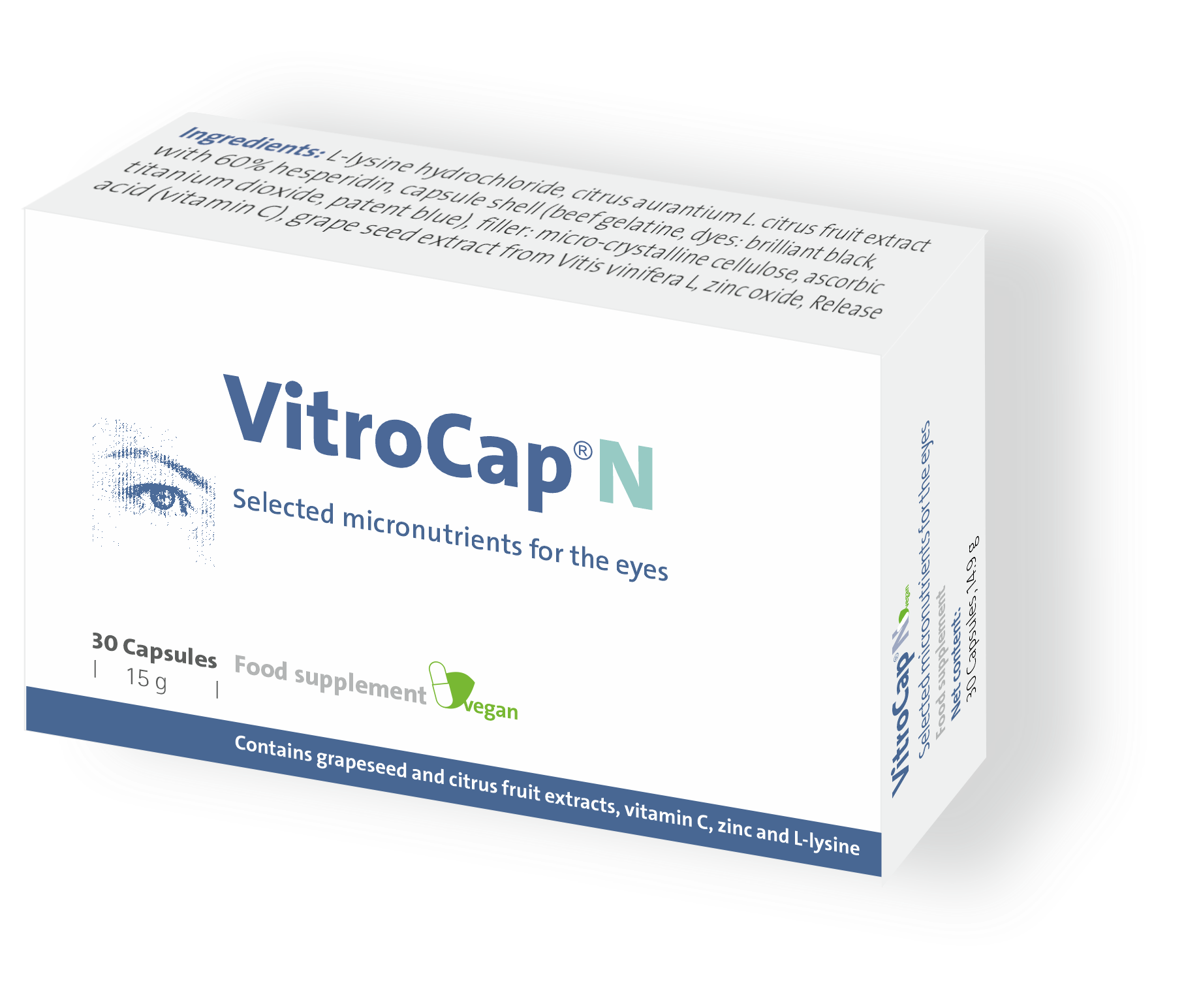Zinc
5 mg
50%

** NRV not established
VitroCap®N is designed to supplement your diet to help support the eye’s need for specific micronutrients. Its main components are as follows:
Storage information: Store in a cool, dry place, in its packaging to protect from light, between 5°–25°C. Keep out of reach of children.
Directions for use: Take one VitroCap®N capsule daily with water and after food for a minimum of 3 to 6 months.
Ingredients: L-lysine hydrochloride, citrus fruit extract (Citrus aurantium L.), capsule shell (coating agent: Hydroxypropyl methyl cellulose, colouring food: spirulina and apple concentrate, invert sugar), filler: microcrystalline cellulose, L-ascorbic acid (vitamin C); grape seed extract (Vitis vinifera L.), Zinc oxide, anti-caking agents: magnesium salts of fatty acids, silicon dioxide
The normal metabolic process of any tissue produces unstable free radicals, which if produced in excess, in a way that overwhelms the body’s ability to regulate them, gives rise to a condition known as oxidative stress.
Oxidative stress is exacerbated in the presence of blue light (a component of visible light [sunlight]). The eye (along with our skin), is the only organ that is exposed to sunlight and its high-energy rays, thus making it more susceptible to oxidative stress.
In the eye, oxidative stress can lead to the disintegration of collagen fibres and structural changes of the vitreous body which affect the transmission of the light and thereby the quality of vision. To maintain function, these structures in the eye require sufficient and specific nutrients. A diet rich in selected micronutrients contributes to maintaining the balance and integrity of collagen fibres and the vitreous body.
Mode of action of dietary support for vitreous body
1. Inhibition of the glycation of collagen fibres
– L-Lysine inhibits the glycation by 76%*2, also acts as a chemical chaperone, a protein required for the proper folding and/or assembly of another protein or protein complex.*11
– Flavonoids (Hesperidin) significantly inhibit the collagen fibres from forming a meshwork.*3
– Zinc has shown antiglycation properties.*12
2. Modulation of the degrading enzymes of hyaluronic acid and collagen
– Procyanidines from grape seed extract (Vitis vinifera) modulate the activity of collagenase, hyaluronidase and elastase.*4, 5
3. Inhibition of the oxidative damage of the collagen fibres
– Ascorbic acid and procyanidine are powerful antioxidants in an aqueous environment.*5, 6, 7
– Zinc exert its antioxidative effects by protecting sulfhydryl groups from oxidation.*8
– Zinc acts as a co-factor for important enzymes involved in the proper functioning of the antioxidant defense system.*9
1. Bishop PN. Structural Macromolecules and Supramolecular Organisation of the Vitreous Gel. Progress in Retinal and Eye Research. 2000; 19: 323-344
2. Sulochana KN, Ramprasad S, Coral K, et al. Glycation and glycoxidation studies in vitro on isolated human vitreous collagen. Med Sci Monit. 2003; 9: BR220-224
3. Urios P, Grigorova-Borsos AM, Sternberg M. Flavonoids inhibit the formation of the cross-linking AGE pentosidine in collagen incubated with glucose, according to their structure. Eur J Nutr. 2007; 46:139-146
4. Lutomski J, Mscisz A. Znaczenie prewencyjne zwiazkow polifenolowych zawartych w winogronach. Postepy Fitoterapii 2003; 1: 6
5. Maffei Facino R, Carini M, Aldini G, et al. Free radicals scavenging action and anti-enzyme activities of procyanidines from Vitis vinifera. A mechanism for their capillary protective action. Arzneimittelforschung. 1994; 44: 592-601
6. Shui YB, Holekamp NM, Kramer BC, et al. The gel state of the vitreous and ascorbate-dependent oxygen consumption: relationship to the etiology of nuclear cataracts. Arch Ophthalmol. 2009; 127: 475-482
7. DiMattio J. A comparative study of ascorbic acid entry into aqueous and vitreous humors of the rat and guinea pig. Invest Ophthalmol Vis Sci. 1989; 30: 2320-2331
8. Konerirajapuram NS, Coral K, Punitham R, Sharma T, Kasinathan N, Sivaramakrishnan R. Trace elements iron, copper and zinc in vitreous of patients with various vitreoretinal diseases. Indian J. Ophthalmol. 2004, 52, 145–148. [PubMed]
9. Marreiro DD, Cruz KJ, Morais JB, Beserra JB, Severo JS, de Oliveira AR. Zinc and Oxidative Stress: Current Mechanisms. Antioxidants (Basel). 2017;6(2):24.
10. Traber MG, Stevens JF. Vitamins C and E: Beneficial effects from a mechanistic perspective. Free Radic. Biol. Med. 2011, 51, 1000–1013. Published 2017 Mar 29. doi:10.3390/antiox6020024
11. Awasthi S, Saraswathi NT. Carbonyl scavenging and chemical chaperon like function of essential amino acids attenuates non-enzymatic glycation of albumin. RSC Adv. 2016;6:24557-24564.
12. Kheirouri S, Alizadeh M, Maleki V. Zinc against advanced glycation end products. Clin Exp Pharmacol Physiol. 2018;45:491-498.
Important instructions: VitroCap®N food supplement is not a substitute for a varied and balanced diet and a healthy lifestyle! Do not exceed the recommended daily amount. Pregnant and breastfeeding women should consult their doctor before use. If you are under medical supervision, taking medication or suffering from a disease, please consult your doctor before taking.